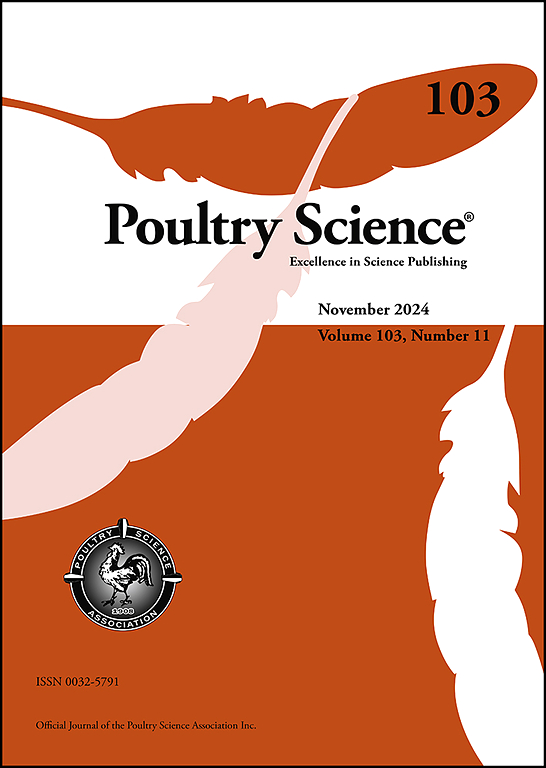橙皮苷通过质子泵途径促进胃酸分泌,提高肉鸡生长性能。
IF 3.8
1区 农林科学
Q1 AGRICULTURE, DAIRY & ANIMAL SCIENCE
引用次数: 0
摘要
橙皮苷作为一种饲料添加剂,在促进动物胃酸分泌方面具有广阔的应用前景。胃肠功能对动物生长和有效消化膳食营养物质至关重要,胃酸分泌是胃肠功能的重要组成部分之一。胃酸的分泌与其他消化液和物质一起,显著影响动物饲料的消化和吸收,进而影响生长性能。然而,橙皮苷作为饲料添加剂用于促进胃酸分泌的研究有限。本研究旨在评价橙皮苷作为饲料添加剂促进胃酸分泌的功效,并阐明其作用机制。选取体重相近的1日龄新孵肉仔鸡200只,随机分为4组:对照组仅饲喂基础饲粮,其余3组分别在基础饲粮中添加50、100和150 mg橙皮苷。每组设5个重复,每个重复10只肉鸡,试验期21 d。试验期间通过监测采食量和体重来评价生长性能。饲养试验结束前进行为期4天的养分利用试验。采用全收集法,将收集的粪便称重,在65℃下干燥。每组15只肉鸡安乐死后立即解剖,取胗、胃前静脉、胃食糜和颈静脉血,称重胃前静脉和胃前静脉重量,同时测定胃食糜pH。采集颈静脉血用于测定胃泌素水平,鸡胗食糜用于测定乳酸、盐酸和胃蛋白酶活性。用胃前部和胗组织评估胃蛋白酶原水平,进行苏木精-伊红(H&E)染色,对关键质子泵组分进行酶联免疫吸附试验(elisa),并评估质子泵活性。结果表明,与对照组相比,100mg/Kg和150 mg/Kg组的末重和平均日增重均显著提高(P < 0.05)。150mg/Kg组料重比显著降低(P < 0.05)。营养物质利用试验结果表明,各处理组的干物质(DM)和粗脂肪(EE)水平均显著高于对照组(P < 0.05)。100mg/Kg和150mg/Kg组的粗蛋白质(CP)和总能(ME)显著高于对照组和50mg/Kg组(P < 0.05)。在肉鸡饲粮中添加橙皮苷可显著改善胃发育和乳酸含量,而pH和盐酸含量则相反(P < 0.05)。在肉鸡饲粮中添加100 mg/Kg和150 mg/Kg橙皮苷显著上调胃蛋白酶活性和胃蛋白酶原水平(P < 0.05)。日粮中添加橙皮苷显著提高了肉鸡的上皮细胞数量(P < 0.05)。肉鸡饲粮中添加橙皮苷可有效上调参与质子泵激活的关键信号通路和细胞内信号物质(P < 0.05)。与100mg/Kg和150mg/Kg对照组相比,质子泵活性也有显著提高(P < 0.05)。综上所述,橙皮苷作为肉仔鸡饲料添加剂具有广阔的应用前景,橙皮苷可以通过激活质子泵,增加胃酸分泌,促进营养物质的利用,从而改善肉仔鸡的生长性能。在基础饲粮中添加150mg/Kg橙皮苷的效果更佳。本文章由计算机程序翻译,如有差异,请以英文原文为准。
Hesperidin enhances broiler growth performance by augmenting gastric acid secretion via the proton pump pathway
Hesperidin exhibits promising potential as a feed additive for augmenting gastric acid secretion in animals. Gastrointestinal function is essential for animal growth and the efficient digestion of dietary nutrients, with gastric acid secretion serving as one of its critical components. The secretion of gastric acid, together with other digestive fluids and substances, significantly influences the digestion and absorption of animal feed, which in turn affects growth performance. However, there is limited research regarding the application of hesperidin as a feed additive to enhance gastric acid secretion. The present study aims to evaluate the efficacy of hesperidin as a feed additive in enhancing gastric acid secretion and to elucidate its underlying mechanisms. A total of 200 newly hatched (1-day-old) broilers with similar body weight were randomly allocated into four groups as follows: the control group receiving only the basal diet, and the other three groups supplemented with 50, 100, and 150 mg of hesperidin per kg of the basal diet, respectively. Each group consisted of five replicates with ten broilers per replicate, and the feeding trial lasted for a duration of 21 days. The growth performance was evaluated by monitoring feed intake and body weight throughout the trial. A four-day nutrient utilization trial was conducted prior to the conclusion of the feeding experiment. Adoption of the total collection method, the collected droppings were weighed and dried at 65 °C. Fifteen broilers from each group were euthanized and immediately dissected to obtain gizzard, proventriculus, gizzard chyme, and jugular blood samples, The proventriculus and gizzard weight were weighed and the pH of gizzard chyme was measured at the same time. The collected jugular venous blood was used to assess gastrin levels, whereas chicken gizzard chyme was utilized for the analysis of lactate, hydrochloric acid, and pepsin activity. Proventriculus and gizzard tissues were used to evaluate pepsinogen levels, perform hematoxylin-eosin (H&E) staining, conduct enzyme-linked immunosorbent assays (ELISAs) for key proton pump components, and assess proton pump activity. The results demonstrated that, in comparison to the control group, both the 100mg/Kg and 150 mg/Kg groups exhibited a significant increase in final body weight (FBW) and average daily gain (ADG) (P < 0.05). Additionally, the feed to gain ratio (F/G) was significantly reduced in the 150mg/Kg group (P < 0.05). The results of the nutrient utilization trial indicate that all treatment groups had significantly higher levels of dry matter (DM) and ether extract (EE) compared to the control group (P < 0.05). Furthermore, crude protein (CP) and gross energy (ME) were significantly higher in the 100mg/Kg and 150mg/Kg groups than in both the control group and the 50mg/Kg group (P < 0.05). The inclusion of hesperidin in broiler diets leads to significant improvements in stomach development and lactic acid content, while pH and hydrochloric acid content exhibit opposite trends (P < 0.05). Supplementation of broiler diets with hesperidin at doses of 100 mg/Kg and 150 mg/Kg significantly up-regulates pepsin activity and pepsinogen levels (P < 0.05). Incorporation of hesperidin into the broilers' diet significantly enhances parietal cell numbers (P < 0.05). Dietary supplementation of hesperidin in broilers effectively up-regulates key signaling pathways and intracellular signal substances involved in proton pump activation (P < 0.05). The proton pump activity also exhibited a significant increase compared to the control group of 100mg/Kg and 150mg/Kg (P < 0.05) in our findings. In conclusion, hesperidin exhibits promising potential as a feed additive for broilers, and it can improve the growth performance of broilers by increasing gastric acid secretion and promoting nutrient utilization through activation of proton pump. Notably, basal diet supplemented with 150mg/Kg hesperidin demonstrates superior efficacy.
求助全文
通过发布文献求助,成功后即可免费获取论文全文。
去求助
来源期刊

Poultry Science
农林科学-奶制品与动物科学
CiteScore
7.60
自引率
15.90%
发文量
0
审稿时长
94 days
期刊介绍:
First self-published in 1921, Poultry Science is an internationally renowned monthly journal, known as the authoritative source for a broad range of poultry information and high-caliber research. The journal plays a pivotal role in the dissemination of preeminent poultry-related knowledge across all disciplines. As of January 2020, Poultry Science will become an Open Access journal with no subscription charges, meaning authors who publish here can make their research immediately, permanently, and freely accessible worldwide while retaining copyright to their work. Papers submitted for publication after October 1, 2019 will be published as Open Access papers.
An international journal, Poultry Science publishes original papers, research notes, symposium papers, and reviews of basic science as applied to poultry. This authoritative source of poultry information is consistently ranked by ISI Impact Factor as one of the top 10 agriculture, dairy and animal science journals to deliver high-caliber research. Currently it is the highest-ranked (by Impact Factor and Eigenfactor) journal dedicated to publishing poultry research. Subject areas include breeding, genetics, education, production, management, environment, health, behavior, welfare, immunology, molecular biology, metabolism, nutrition, physiology, reproduction, processing, and products.
 求助内容:
求助内容: 应助结果提醒方式:
应助结果提醒方式:


